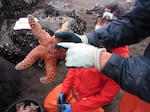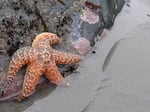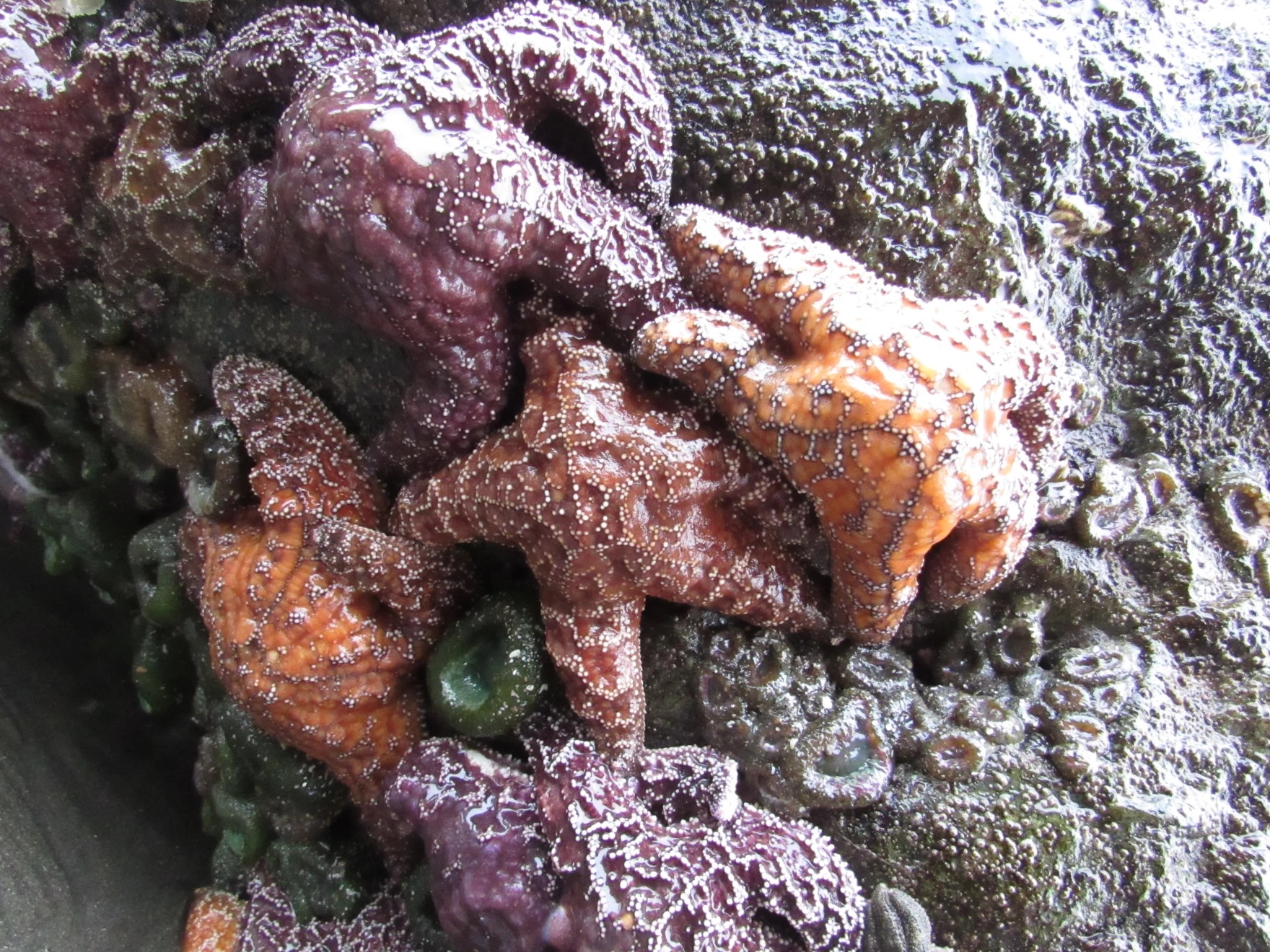A crew of researchers clad in orange fishing bibs trudges out to the rocky shore.
It’s early in the morning — their visit timed to capture the brief window when the tides are so low they reveal a usually-hidden intertidal spectacle. Clinging to the exposed rocks, among the mussels and wobbly sea anemones, are sea stars, colored in hues of tangerine and violet.
The researchers’ mission? To pry the ochre sea stars off the rocks, then measure and weigh them.
Laurel Field is a faculty research assistant in the Menge Lubchenco Lab at Oregon State University. She led the team to this spot on Oregon’s South Coast.
“All these organisms live underwater a lot of the time when the tide’s up,” she says. “The sea stars are moving around and crawling around and eating all these organisms, and when we come to do our research, they’re all just paused, like exactly what they were doing, where they were, right when the tide went out.”

Oregon State University researcher Laurel Field holds an ochre sea star before it is measured and weighed.
Kate Kaye / JPR News
You may have heard about how a different kind of sea star — the sunflower sea star — was recently deemed critically endangered. They were red-listed as a result of a devastating ailment that hit the Pacific Coast in 2013 and 2014 called sea star wasting disease.
But these ochre sea stars are the top-of-the-food-chain closer to the shore in the rocky tidepools — and they’re coming back.
Sarah Gravem is a research associate and marine community ecologist at OSU.
“We just saw this gangbusters year of babies, right after sea star wasting disease and that happened in a lot of other places too,” she says.
So, the big question is: why are ochre sea stars returning, while sunflower stars have practically disappeared?
Scientists say one of the places on Oregon’s South Coast where sea star research like this has been conducted for years could offer clues: Cape Blanco.
Cape Blanco is the westernmost point in Oregon.
Seabirds here fly over steep rock faces and craggy boulders. There are crabs, kelps and fishes.
Related: Study pins toxic algae blooms at Oregon’s southern border on climate change
Research data seems to indicate that the last area long the entire North American Pacific Coast to be struck by sea star wasting disease was the region of Curry County where Cape Blanco lies.
Experts are still trying to figure it all out, says Larry Basch, a research associate at the University of Oregon’s Institute of Marine Biology.
“We’re far from being able to say definitively why this area seemed to act like a refuge from the disease for so long,” he says. But the data show we didn’t see any sign of sea star wasting for a very long time after the entire rest of the coast was reporting it.”

An ochre sea star clings to a rock at low tide on Oregon’s South Coast.
Kate Kaye / JPR News
Basch and others say Cape Blanco is critically important because it has been a research area for decades, revealing insights that can only emerge through extended research.
And that’s why researchers have proposed that Cape Blanco be designated by the state as a Marine Research Area.
Field helped lead work on the proposal.
“A research reserve allows scientists to come out and do their work but it by no means restricts people from going and exploring those areas,” she says.
Rather than imposing any new restrictions on harvesting, tidepooling or dog-walking, the proposal, if approved, would formally designate Cape Blanco as a scientific research site.
It’s actually one of many community-led proposals submitted to the state’s Ocean Policy Advisory Council for educational, research and conservation-related designations for rocky intertidal sites along the Oregon Coast.
While there are signs of recovery for ochre sea stars, researchers like Field say they must continue watching for sea star wasting disease flare-ups.
“This work is just so important going forward to keep monitoring and keep an eye out for, if it ever happens again we need to be on it, and like, trying to get to the bottom of it.”
The proposals for Cape Blanco and other rocky intertidal sites will be made available in March for public comment.
Correction: Cape Blanco is the westernmost point in Oregon. An earlier version of this story misstated its geographic location within the broader United States. The westernmost point in the continental U.S. is Cape Alva, a bit further west. We regret the error.
